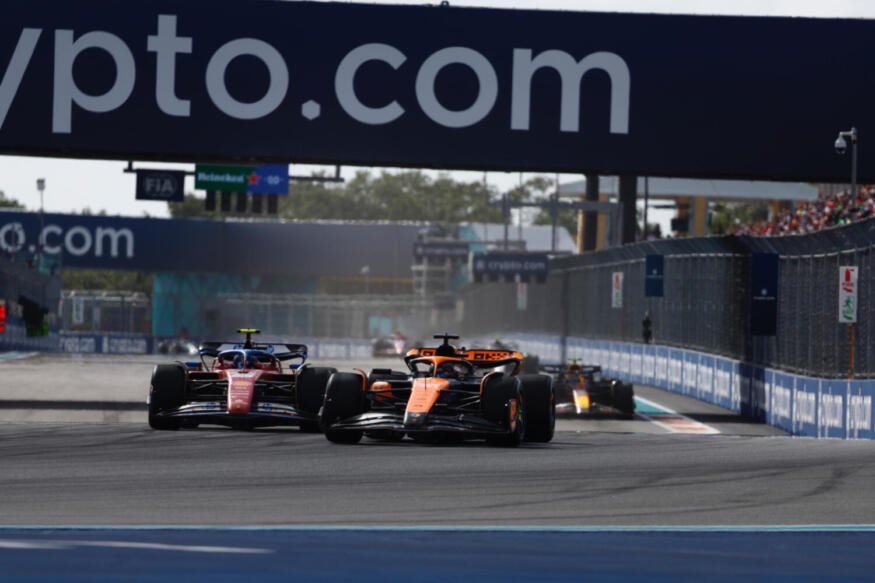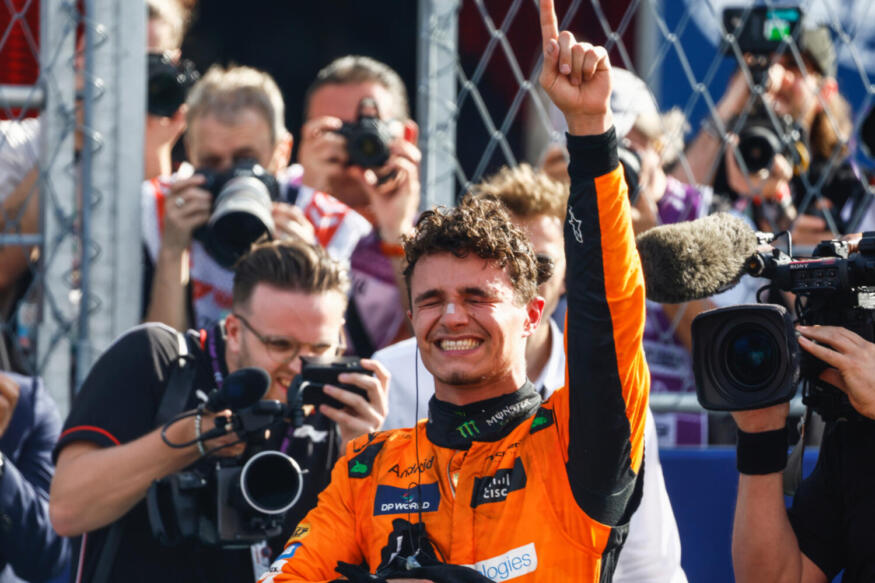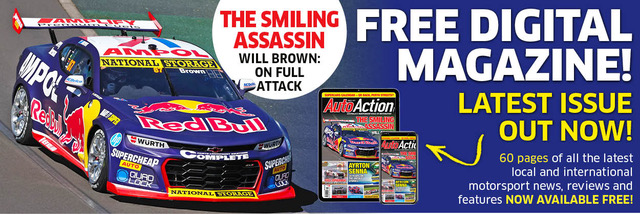Norris outpaces Verstappen to secure maiden victory in Miami

By Reese Mautone
Date posted: 6 May 2024
After 110 races in Formula 1, Lando Norris finally secured his maiden victory at the Miami Grand Prix, capitalising on a mid-race Safety Car and putting the MCL38’s extensive upgrades to work to beat Max Verstappen to the top step.
Max Verstappen had never been beaten in Miami, seeing the Red Bull driver charging into Turn 1 with plans of keeping it that way.
The Dutchman was gifted a stress-free run to the first braking zone, with front-row starter Charles Leclerc slow off the line.
Although clear from the threat of the Ferrari, Verstappen’s own teammate nearly bowled him out after losing control at the opening turn.
Leclerc, Sergio Perez and Carlos Sainz were almost three wide as they approached the Turn 1 Apex, with the Mexican also narrowly missing the “blue” Ferraris as they turned in.
Oscar Piastri was able to capitalise on the avoidant moves from the top four drivers, making up three places and splitting the Ferraris by Turn 3.
Instantly, the Alpines had formed a tense battle for P12, almost making contact with one another and the wall through Turn 14 and Turn 16, before running two-wide at Turn 17.
Ultimately, it was Pierre Gasly who ended on top, passing his teammate as they excited the tight hairpin.
Ocon lost two further places to Fernando Alonso and Alex Albon on the following lap, worsening the blow for the Alpine driver.
By lap three, Verstappen was over 1.5 seconds clear of Leclerc in P2, leaving the #16 defenceless against the charging McLaren behind.

Max Verstappen leads the field away at the start of the Miami GP. Image: Alexander Trienitz / LAT Images.
Piastri found himself six-tenths behind Leclerc, utilising the drastic DRS advantage down the back straight to make the overtake stick into Turn 17.
Leclerc’s focus then shifted to a battle with his teammate, with Sainz breathing down his neck into the first corner.
The Spaniard took to his radio to inform his team that he had pace, as Sainz ran five-tenths behind the #16.
Lewis Hamilton, the only driver in the top ten to start on the hard compound tyre, felt his tyres finally coming to.
Just as he had in the Sprint, the Mercedes driver was busy fighting a Haas.
Nico Hulkenberg had earlier capitalised on Hamilton’s Turn 17 lock up, passing the #44 in the process, however, Hamilton wasn’t letting him off easily.
The pairing nearly collided at Turn 11, the place where the eventual move would be made on Lap 11 as Hamilton cruised off into the distance.
Hulkenberg then had the second-running Mercedes for company, with George Russell challenging the Haas driver just metres later on the back straight.
He had to withhold, with his mission made more difficult on Lap 12 after locking up.
That didn’t stop Russell, however, with the young Brit replicating his teammate’s overtake at Turn 11.
Alex Albon was the first driver to make a pitstop, rejoining the race on the hard tyre and in last place.
On Lap 13, others followed suit with Gasly and Hulkenberg relinquishing their medium tyres for the hard compound.
Running a lonely race in P5 and P6, Perez and Norris were engaged in a battle of their own.
The upgraded McLaren had a look at a Lap-15 move on Perez, running five-tenths behind the Mexican, however, it wasn’t to be.

Lando Norris during the Miami GP. Image: Steven Tee / LAT Images.
Verstappen hadn’t formed the usual gap out in front, running around three seconds ahead of Piastri.
The Red Bull pit wall gave the Dutchman the all-clear to stop managing his tyres, however, the gap never grew.
On Lap 18, the team called Sergio Perez into the pits for a 1.9-second stop, rejoining the race in P10.
This released Norris to hunt down Sainz, starting at a 5-second deficit.
Sainz started to drop off the back of his teammate, saving his tyres as the team made it clear team orders wouldn’t be coming into play.
Leclerc was then called into the pitlane to relinquish his 19-lap-old medium tyres, rejoining the race in P6 after a brilliant 1.9-second stop.
Norris began setting fastest sectors, earning the fastest lap as he made gains on the #55 Ferrari.
The coveted extra point was soon handed to Leclerc, who immediately began putting his fresh tyres to work as he passed Hamilton through Turn 11.
Out front, Verstappen made a rare driver error at Turn 14, running over the kerb and taking out the bollard.
The RB20 carried the bollard to Turn 16, disposing of it in a dangerous position on the racing line.
The race was soon neutralised after a Virtual Safety Car was called, allowing the track marshals to clear the track.
The VSC allowed a small batch of back-markers to capitalise on the reduced pitstop loss, with the likes of Alonso and his rivals stopping by.
On Lap 23, the race leader pulled into the pits, donning a fresh set of hard tyres and undergoing a slight front-wing adjustment before rejoining in P4.
It was a four-way battle for P12 between Ocon, Hulkenberg, Alonso and Gasly, however, the quartet was soon invaded by the #63 who filed out of the pitlane and into the think of it.
Alonso, running fresh mediums, passed the Haas for P13, setting off for Esteban Ocon.

Esteban Ocon leads Fernando Alonso during the Miami GP. Image: Sam Bloxham / LAT Images.
The race leader and Sainz both pitted on Lap 27, rejoining in P4 and P5, however that would be an unfortunate choice was an incident unfolding just a lap later.
Logan Sargeant and Kevin Magnussen collided at Turn 2, with the Williams driver spinning and ending his home race in the barriers.
Magnussen escaped with front wing damage and was able to continue running in the Miami Grand Prix.
The race restarted on Lap 33, with Norris dashing to the line from Turn 19, having Max Verstappen for company.
The Red Bull driver seemingly made a mistake at Turn 8, allowing the gap to grow to 1.4 seconds.
The battle between Piastri and Sainz became a tense one after the duo made contact at Turn 11.
The Australian encouraged the Ferrari to run wide after Sainz attempted an overtake into the popular corner, also banging his rear wheel into the Spaniard’s sidepod.
The Ferrari driver and his pit wall were calling for the #81 to give the position to Sainz, however, race control deemed no investigation necessary.
The Spaniard was audibly frustrated, driving out of anger as he made multiple attempts over the next few laps.
However, on Lap 40 at Turn 17, Sainz finally got past the McLaren.
It wasn’t a clean move, with Sainz’s hard tyres barely managing the overtake around the sharp hairpin.
As a result of the mid-corner struggle, Piastri made contact with the Spaniard’s rear wheel, significantly damaging his front wing.
The incident was to be investigated after the race.

Oscar Piastri battles with Carlos Sainz during the Miami GP. Image: Sam Bloxham / LAT Images.
Piastri was called into the pits, dropping all the way back to last place after requiring a front-wing change.
The 23-year-old set the fastest lap, however, running in P19, no extra point would be awarded.
Daniel Ricciardo had Lance Stroll for cautious company, with the duo tussling across Lap 46.
At Turn 3, the Canadian passed the Australian, demoting Ricciardo to P16.
With 10 laps remaining, Lando Norris had built a gap of over five seconds to Verstappen, with the Red Bull driver clearly unhappy with the handling of his RB20.
The front-running Aston Martin pulled off a move of his own, finally passing Ocon into the braking zone at Turn 11.
The two Australians were racing wheel-to-wheel through Turn 17, continuing into the first sector of the next lap.
As the battle heated up, Piastri was reminded that, with his teammate in the lead, causing a Safety Car would be catastrophic.
As a result, the #81 settled down, however, still passing Ricciardo on Lap 55.
Beginning, the final lap with a 7.5-second interval to second place, the win was only Norris’ for the taking.
The #4 crossed the line to claim his maiden victory in Formula 1, deafening his engineer’s ear as he screamed with excitement.

Lando Norris celebrates on arrival in Parc Ferme after winning the Miami GP. Image: Sam Bloxham / LAT Images.
Behind him, a troubled Max Verstappen crossed the line in second, with Charles Leclerc less than two seconds behind, completing the podium places in Miami.
Carlos Sainz, still caught up with a post-race investigation, finished in P4 after closing in on his teammate in the late stages of the 57-lap race.
Sergio Perez held out over Lewis Hamilton as they crossed the finish line, separated by just 1.9 seconds.
Along with the race leader, Yuki Tsunoda was another driver who gained an advantage under the Safety Car, finishing the Miami Grand Prix in P7 to end his weekend with two points finishes.
George Russell was a fair while back on the RB driver, ending his day in P8 with Fernando Alonso for company.
In tenth place, Esteban Ocon scored Alpine’s first point of the season, a welcomed reward for the Frenchman who valiantly held out in the tense mid-field battle.
Lando Norris and McLaren will be able to celebrate for the next 7 days before heading to Imola for the Emilia-Romagna Grand Prix from May 17-19.
Miami Grand Prix Results:
| POS |
NO |
DRIVER |
CAR |
LAPS |
TIME/RETIRED |
PTS |
| 1 |
4 |
Lando Norris |
MCLAREN MERCEDES |
57 |
1:30:49.876 |
25 |
| 2 |
1 |
Max Verstappen |
RED BULL RACING HONDA RBPT |
57 |
+7.612s |
18 |
| 3 |
16 |
Charles Leclerc |
FERRARI |
57 |
+9.920s |
15 |
| 4 |
55 |
Carlos Sainz |
FERRARI |
57 |
+11.407s |
12 |
| 5 |
11 |
Sergio Perez |
RED BULL RACING HONDA RBPT |
57 |
+14.650s |
10 |
| 6 |
44 |
Lewis Hamilton |
MERCEDES |
57 |
+16.585s |
8 |
| 7 |
22 |
Yuki Tsunoda |
RB HONDA RBPT |
57 |
+26.185s |
6 |
| 8 |
63 |
George Russell |
MERCEDES |
57 |
+34.789s |
4 |
| 9 |
14 |
Fernando Alonso |
ASTON MARTIN ARAMCO MERCEDES |
57 |
+37.107s |
2 |
| 10 |
31 |
Esteban Ocon |
ALPINE RENAULT |
57 |
+39.746s |
1 |
| 11 |
27 |
Nico Hulkenberg |
HAAS FERRARI |
57 |
+40.789s |
0 |
| 12 |
10 |
Pierre Gasly |
ALPINE RENAULT |
57 |
+44.958s |
0 |
| 13 |
81 |
Oscar Piastri |
MCLAREN MERCEDES |
57 |
+49.756s |
0 |
| 14 |
24 |
Zhou Guanyu |
KICK SAUBER FERRARI |
57 |
+49.979s |
0 |
| 15 |
3 |
Daniel Ricciardo |
RB HONDA RBPT |
57 |
+50.956s |
0 |
| 16 |
77 |
Valtteri Bottas |
KICK SAUBER FERRARI |
57 |
+52.356s |
0 |
| 17 |
18 |
Lance Stroll |
ASTON MARTIN ARAMCO MERCEDES |
57 |
+55.173s |
0 |
| 18 |
20 |
Kevin Magnussen |
HAAS FERRARI |
57 |
+64.683s |
0 |
| 19 |
23 |
Alexander Albon |
WILLIAMS MERCEDES |
57 |
+76.091s |
0 |
| NC |
2 |
Logan Sargeant |
WILLIAMS MERCEDES |
27 |
DNF |
0 |
Don’t forget the latest issue of Auto Action will be available via subscription here or at selected outlets. For more of the latest motorsport news, subscribe to AUTO ACTION magazine.

Podcast: The untold Senna stories | New look Supercars calendar and more

It is 30 years since Ayrton Senna died at Imola, and our crew goes behind the scenes with untold stories. Plus, where will Adrian Newey go, and is he worth €150 a year?
Plus, NASCAR, IndyCar, WEC, IMSA and Motorsport Australia dump $1m!
Listen to our latest episode on your podcast app of choice or here


Recent Stories
array (
0 =>
WP_Term::__set_state(array(
'term_id' => 37,
'name' => 'F1',
'slug' => 'f1',
'term_group' => 0,
'term_taxonomy_id' => 37,
'taxonomy' => 'category',
'description' => 'An Introduction to Formula One (F1)
Formula One, or F1, is the highest class of single-seater auto racing, governed by the Fédération Internationale de l\'Automobile (FIA) and is owned by Liberty Media. The name "Formula One" refers to the set of rules or formula that all cars and drivers must comply with.
The F1 season consists of a series of races, known as Grands Prix, held on purpose-built circuits or public roads around the world. The results of each race are combined to determine two annual championships: one for drivers and one for constructors (teams).
The history of Formula One can be traced back to the pre-war Grand Prix racing, which featured open-wheel cars with supercharged engines. The first World Championship of Drivers was organised by the FIA in 1950, following the end of World War II. The first race was held at Silverstone, England, and was won by Giuseppe Farina, driving an Alfa Romeo. The first constructors\' championship was introduced in 1958 and was won by Vanwall.
Formula One has seen many changes and innovations over the years, both in terms of technology and regulations. Some of the most notable developments include the introduction of rear-engined cars in the late 1950s, the use of aerodynamic wings in the late 1960s, the adoption of turbocharged engines in the late 1970s, the emergence of electronic driver aids in the late 1980s, the switch to V10 and then V8 engines in the 1990s and 2000s, and the introduction of hybrid power units in 2014.
Formula One has also produced some of the greatest drivers and rivalries in the history of motorsport. Some of the most famous names include Juan Manuel Fangio, Jim Clark, Jackie Stewart, Niki Lauda, Ayrton Senna, Alain Prost, Michael Schumacher, Lewis Hamilton, and Sebastian Vettel. Some of the most intense battles for the championship have been between Fangio and Stirling Moss in the 1950s, Lauda and James Hunt in the 1970s, Senna and Prost in the late 1980s, Schumacher and Mika Hakkinen in the late 1990s, and Hamilton and Vettel in the 2010s.
Formula One is widely regarded as the pinnacle of motorsport, attracting millions of fans and viewers worldwide. The sport is also a huge business, involving billions of dollars in revenue and expenditure. The teams compete for prize money, sponsorship deals, and media rights, while the drivers earn millions of dollars in salaries and endorsements. The sport is also influenced by politics, regulations, and controversies, such as doping scandals, espionage cases, safety issues, and environmental concerns.
The following is a list of all F1 World Drivers Champions by year, from 1950 to 2020:
1950-1959
1950: Giuseppe Farina (Italy) - Alfa Romeo 158, Alfa Romeo
1951: Juan Manuel Fangio (Argentina) - Alfa Romeo 159, Alfa Romeo
1952: Alberto Ascari (Italy) - Ferrari 500, Ferrari
1953: Alberto Ascari (Italy) - Ferrari 500, Ferrari
1954: Juan Manuel Fangio (Argentina) - Maserati 250F, Maserati / Mercedes-Benz W196, Mercedes-Benz
1955: Juan Manuel Fangio (Argentina) - Mercedes-Benz W196, Mercedes-Benz
1956: Juan Manuel Fangio (Argentina) - Ferrari D50, Ferrari
1957: Juan Manuel Fangio (Argentina) - Maserati 250F, Maserati
1958: Mike Hawthorn (United Kingdom) - Ferrari 246, Ferrari
1959: Jack Brabham (Australia) - Cooper T51, Cooper-Climax
1960-1969
1960: Jack Brabham (Australia) - Cooper T53, Cooper-Climax
1961: Phil Hill (United States) - Ferrari 156, Ferrari
1962: Graham Hill (United Kingdom) - BRM P57, BRM
1963: Jim Clark (United Kingdom) - Lotus 25, Lotus-Climax
1964: John Surtees (United Kingdom) - Ferrari 158, Ferrari
1965: Jim Clark (United Kingdom) - Lotus 33, Lotus-Climax
1966: Jack Brabham (Australia) - Brabham BT19, Brabham-Repco
1967: Denny Hulme (New Zealand) - Brabham BT20, Brabham-Repco
1968: Graham Hill (United Kingdom) - Lotus 49, Lotus-Ford
1969: Jackie Stewart (United Kingdom) - Matra MS80, Matra-Ford
1970-1979
1970: Jochen Rindt (Austria) - Lotus 72, Lotus-Ford
1971: Jackie Stewart (United Kingdom) - Tyrrell 003, Tyrrell-Ford
1972: Emerson Fittipaldi (Brazil) - Lotus 72D, Lotus-Ford
1973: Jackie Stewart (United Kingdom) - Tyrrell 006, Tyrrell-Ford
1974: Emerson Fittipaldi (Brazil) - McLaren M23, McLaren-Ford
1975: Niki Lauda (Austria) - Ferrari 312T, Ferrari
1976: James Hunt (United Kingdom) - McLaren M23, McLaren-Ford
1977: Niki Lauda (Austria) - Ferrari 312T2, Ferrari
1978: Mario Andretti (United States) - Lotus 79, Lotus-Ford
1979: Jody Scheckter (South Africa) - Ferrari 312T4, Ferrari
1980-1989
1980: Alan Jones (Australia) - Williams FW07B, Williams-Ford
1981: Nelson Piquet (Brazil) - Brabham BT49C, Brabham-Ford
1982: Keke Rosberg (Finland) - Williams FW08, Williams-Ford
1983: Nelson Piquet (Brazil) - Brabham BT52, Brabham-BMW
1984: Niki Lauda (Austria) - McLaren MP4/2, McLaren-TAG
1985: Alain Prost (France) - McLaren MP4/2B, McLaren-TAG
1986: Alain Prost (France) - McLaren MP4/2C, McLaren-TAG
1987: Nelson Piquet (Brazil) - Williams FW11B, Williams-Honda
1988: Ayrton Senna (Brazil) - McLaren MP4/4, McLaren-Honda
1989: Alain Prost (France) - McLaren MP4/5, McLaren-Honda
1990-1999
1990: Ayrton Senna (Brazil) - McLaren MP4/5B, McLaren-Honda
1991: Ayrton Senna (Brazil) - McLaren MP4/6, McLaren-Honda
1992: Nigel Mansell (United Kingdom) - Williams FW14B, Williams-Renault
1993: Alain Prost (France) - Williams FW15C, Williams-Renault
1994: Michael Schumacher (Germany) - Benetton B194, Benetton-Ford
1995: Michael Schumacher (Germany) - Benetton B195, Benetton-Renault
1996: Damon Hill (United Kingdom) - Williams FW18, Williams-Renault
1997: Jacques Villeneuve (Canada) - Williams FW19, Williams-Renault
1998: Mika Häkkinen (Finland) - McLaren MP4/13, McLaren-Mercedes
1999: Mika Häkkinen (Finland) - McLaren MP4/14, McLaren-Mercedes
2000-2009
2000: Michael Schumacher (Germany) - Ferrari F1-2000, Ferrari
2001: Michael Schumacher (Germany) - Ferrari F2001, Ferrari
2002: Michael Schumacher (Germany) - Ferrari F2002, Ferrari
2003: Michael Schumacher (Germany) - Ferrari F2003-GA, Ferrari
2004: Michael Schumacher (Germany) - Ferrari F2004, Ferrari
2005: Fernando Alonso (Spain) - Renault R25, Renault
2006: Fernando Alonso (Spain) - Renault R26, Renault
2007: Kimi Räikkönen (Finland) - Ferrari F2007, Ferrari
2008: Lewis Hamilton (United Kingdom) - McLaren MP4-23, McLaren-Mercedes
2009: Jenson Button (United Kingdom) - Brawn BGP 001, Brawn-Mercedes
2010-2020
2010: Sebastian Vettel (Germany) - Red Bull RB6, Red Bull-Renault
2011: Sebastian Vettel (Germany) - Red Bull RB7, Red Bull-Renault
2012: Sebastian Vettel (Germany) - Red Bull RB8, Red Bull-Renault
2013: Sebastian Vettel (Germany) - Red Bull RB9, Red Bull-Renault
2014: Lewis Hamilton (United Kingdom) - Mercedes F1 W05 Hybrid, Mercedes
2015: Lewis Hamilton (United Kingdom) - Mercedes F1 W06 Hybrid, Mercedes
2016: Nico Rosberg (Germany) - Mercedes F1 W07 Hybrid, Mercedes
2017: Lewis Hamilton (United Kingdom) - Mercedes F1 W08 EQ Power+, Mercedes
2018: Lewis Hamilton (United Kingdom) - Mercedes F1 W09 EQ Power+, Mercedes
2019: Lewis Hamilton (United Kingdom) - Mercedes F1 W10 EQ Power+, Mercedes
2020: Lewis Hamilton (United Kingdom) - Mercedes F1 W11 EQ Power+, Mercedes
2021-
2021: Max Verstappen (Netherlands) – Red Bull RB16B, Honda
2022: Max Verstappen (Netherlands) – Red Bull RB18, Red Bull Power Trains Honda
2023: Max Verstappen (Netherlands) – Red Bull RB19, Red Bull Power Trains Honda
2024: Max Verstappen (Netherlands) – Red Bull RB20, Red Bull Power Trains Honda',
'parent' => 660,
'count' => 2850,
'filter' => 'raw',
'cat_ID' => 37,
'category_count' => 2850,
'category_description' => 'An Introduction to Formula One (F1)
Formula One, or F1, is the highest class of single-seater auto racing, governed by the Fédération Internationale de l\'Automobile (FIA) and is owned by Liberty Media. The name "Formula One" refers to the set of rules or formula that all cars and drivers must comply with.
The F1 season consists of a series of races, known as Grands Prix, held on purpose-built circuits or public roads around the world. The results of each race are combined to determine two annual championships: one for drivers and one for constructors (teams).
The history of Formula One can be traced back to the pre-war Grand Prix racing, which featured open-wheel cars with supercharged engines. The first World Championship of Drivers was organised by the FIA in 1950, following the end of World War II. The first race was held at Silverstone, England, and was won by Giuseppe Farina, driving an Alfa Romeo. The first constructors\' championship was introduced in 1958 and was won by Vanwall.
Formula One has seen many changes and innovations over the years, both in terms of technology and regulations. Some of the most notable developments include the introduction of rear-engined cars in the late 1950s, the use of aerodynamic wings in the late 1960s, the adoption of turbocharged engines in the late 1970s, the emergence of electronic driver aids in the late 1980s, the switch to V10 and then V8 engines in the 1990s and 2000s, and the introduction of hybrid power units in 2014.
Formula One has also produced some of the greatest drivers and rivalries in the history of motorsport. Some of the most famous names include Juan Manuel Fangio, Jim Clark, Jackie Stewart, Niki Lauda, Ayrton Senna, Alain Prost, Michael Schumacher, Lewis Hamilton, and Sebastian Vettel. Some of the most intense battles for the championship have been between Fangio and Stirling Moss in the 1950s, Lauda and James Hunt in the 1970s, Senna and Prost in the late 1980s, Schumacher and Mika Hakkinen in the late 1990s, and Hamilton and Vettel in the 2010s.
Formula One is widely regarded as the pinnacle of motorsport, attracting millions of fans and viewers worldwide. The sport is also a huge business, involving billions of dollars in revenue and expenditure. The teams compete for prize money, sponsorship deals, and media rights, while the drivers earn millions of dollars in salaries and endorsements. The sport is also influenced by politics, regulations, and controversies, such as doping scandals, espionage cases, safety issues, and environmental concerns.
The following is a list of all F1 World Drivers Champions by year, from 1950 to 2020:
1950-1959
1950: Giuseppe Farina (Italy) - Alfa Romeo 158, Alfa Romeo
1951: Juan Manuel Fangio (Argentina) - Alfa Romeo 159, Alfa Romeo
1952: Alberto Ascari (Italy) - Ferrari 500, Ferrari
1953: Alberto Ascari (Italy) - Ferrari 500, Ferrari
1954: Juan Manuel Fangio (Argentina) - Maserati 250F, Maserati / Mercedes-Benz W196, Mercedes-Benz
1955: Juan Manuel Fangio (Argentina) - Mercedes-Benz W196, Mercedes-Benz
1956: Juan Manuel Fangio (Argentina) - Ferrari D50, Ferrari
1957: Juan Manuel Fangio (Argentina) - Maserati 250F, Maserati
1958: Mike Hawthorn (United Kingdom) - Ferrari 246, Ferrari
1959: Jack Brabham (Australia) - Cooper T51, Cooper-Climax
1960-1969
1960: Jack Brabham (Australia) - Cooper T53, Cooper-Climax
1961: Phil Hill (United States) - Ferrari 156, Ferrari
1962: Graham Hill (United Kingdom) - BRM P57, BRM
1963: Jim Clark (United Kingdom) - Lotus 25, Lotus-Climax
1964: John Surtees (United Kingdom) - Ferrari 158, Ferrari
1965: Jim Clark (United Kingdom) - Lotus 33, Lotus-Climax
1966: Jack Brabham (Australia) - Brabham BT19, Brabham-Repco
1967: Denny Hulme (New Zealand) - Brabham BT20, Brabham-Repco
1968: Graham Hill (United Kingdom) - Lotus 49, Lotus-Ford
1969: Jackie Stewart (United Kingdom) - Matra MS80, Matra-Ford
1970-1979
1970: Jochen Rindt (Austria) - Lotus 72, Lotus-Ford
1971: Jackie Stewart (United Kingdom) - Tyrrell 003, Tyrrell-Ford
1972: Emerson Fittipaldi (Brazil) - Lotus 72D, Lotus-Ford
1973: Jackie Stewart (United Kingdom) - Tyrrell 006, Tyrrell-Ford
1974: Emerson Fittipaldi (Brazil) - McLaren M23, McLaren-Ford
1975: Niki Lauda (Austria) - Ferrari 312T, Ferrari
1976: James Hunt (United Kingdom) - McLaren M23, McLaren-Ford
1977: Niki Lauda (Austria) - Ferrari 312T2, Ferrari
1978: Mario Andretti (United States) - Lotus 79, Lotus-Ford
1979: Jody Scheckter (South Africa) - Ferrari 312T4, Ferrari
1980-1989
1980: Alan Jones (Australia) - Williams FW07B, Williams-Ford
1981: Nelson Piquet (Brazil) - Brabham BT49C, Brabham-Ford
1982: Keke Rosberg (Finland) - Williams FW08, Williams-Ford
1983: Nelson Piquet (Brazil) - Brabham BT52, Brabham-BMW
1984: Niki Lauda (Austria) - McLaren MP4/2, McLaren-TAG
1985: Alain Prost (France) - McLaren MP4/2B, McLaren-TAG
1986: Alain Prost (France) - McLaren MP4/2C, McLaren-TAG
1987: Nelson Piquet (Brazil) - Williams FW11B, Williams-Honda
1988: Ayrton Senna (Brazil) - McLaren MP4/4, McLaren-Honda
1989: Alain Prost (France) - McLaren MP4/5, McLaren-Honda
1990-1999
1990: Ayrton Senna (Brazil) - McLaren MP4/5B, McLaren-Honda
1991: Ayrton Senna (Brazil) - McLaren MP4/6, McLaren-Honda
1992: Nigel Mansell (United Kingdom) - Williams FW14B, Williams-Renault
1993: Alain Prost (France) - Williams FW15C, Williams-Renault
1994: Michael Schumacher (Germany) - Benetton B194, Benetton-Ford
1995: Michael Schumacher (Germany) - Benetton B195, Benetton-Renault
1996: Damon Hill (United Kingdom) - Williams FW18, Williams-Renault
1997: Jacques Villeneuve (Canada) - Williams FW19, Williams-Renault
1998: Mika Häkkinen (Finland) - McLaren MP4/13, McLaren-Mercedes
1999: Mika Häkkinen (Finland) - McLaren MP4/14, McLaren-Mercedes
2000-2009
2000: Michael Schumacher (Germany) - Ferrari F1-2000, Ferrari
2001: Michael Schumacher (Germany) - Ferrari F2001, Ferrari
2002: Michael Schumacher (Germany) - Ferrari F2002, Ferrari
2003: Michael Schumacher (Germany) - Ferrari F2003-GA, Ferrari
2004: Michael Schumacher (Germany) - Ferrari F2004, Ferrari
2005: Fernando Alonso (Spain) - Renault R25, Renault
2006: Fernando Alonso (Spain) - Renault R26, Renault
2007: Kimi Räikkönen (Finland) - Ferrari F2007, Ferrari
2008: Lewis Hamilton (United Kingdom) - McLaren MP4-23, McLaren-Mercedes
2009: Jenson Button (United Kingdom) - Brawn BGP 001, Brawn-Mercedes
2010-2020
2010: Sebastian Vettel (Germany) - Red Bull RB6, Red Bull-Renault
2011: Sebastian Vettel (Germany) - Red Bull RB7, Red Bull-Renault
2012: Sebastian Vettel (Germany) - Red Bull RB8, Red Bull-Renault
2013: Sebastian Vettel (Germany) - Red Bull RB9, Red Bull-Renault
2014: Lewis Hamilton (United Kingdom) - Mercedes F1 W05 Hybrid, Mercedes
2015: Lewis Hamilton (United Kingdom) - Mercedes F1 W06 Hybrid, Mercedes
2016: Nico Rosberg (Germany) - Mercedes F1 W07 Hybrid, Mercedes
2017: Lewis Hamilton (United Kingdom) - Mercedes F1 W08 EQ Power+, Mercedes
2018: Lewis Hamilton (United Kingdom) - Mercedes F1 W09 EQ Power+, Mercedes
2019: Lewis Hamilton (United Kingdom) - Mercedes F1 W10 EQ Power+, Mercedes
2020: Lewis Hamilton (United Kingdom) - Mercedes F1 W11 EQ Power+, Mercedes
2021-
2021: Max Verstappen (Netherlands) – Red Bull RB16B, Honda
2022: Max Verstappen (Netherlands) – Red Bull RB18, Red Bull Power Trains Honda
2023: Max Verstappen (Netherlands) – Red Bull RB19, Red Bull Power Trains Honda
2024: Max Verstappen (Netherlands) – Red Bull RB20, Red Bull Power Trains Honda',
'cat_name' => 'F1',
'category_nicename' => 'f1',
'category_parent' => 660,
)),
1 =>
WP_Term::__set_state(array(
'term_id' => 11,
'name' => 'Latest News',
'slug' => 'latest-news',
'term_group' => 0,
'term_taxonomy_id' => 11,
'taxonomy' => 'category',
'description' => '',
'parent' => 0,
'count' => 16554,
'filter' => 'raw',
'cat_ID' => 11,
'category_count' => 16554,
'category_description' => '',
'cat_name' => 'Latest News',
'category_nicename' => 'latest-news',
'category_parent' => 0,
)),
)













